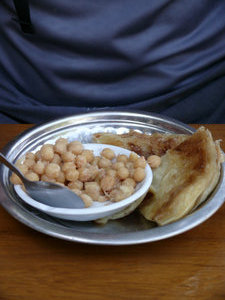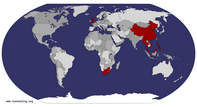Advertisement
Published: January 14th 2013

 Rotinan & beans
Rotinan & beans
Mandalay tea shop staple8 January 2013
This is going to be a difficult one. maybe I should give it some time before writing about Mandalay. The emotions are strong and will surely cloud the dusty reality. We had no expectations flying into Mandalay. Everything I have ever read about visiting this city with the romantic name and connotations, has been negative. From guide books to blogs, nobody raves about Mandalay. We were intending to stay a night and then get moving on to Bagan, but fortunately that didn't happen. This is why we travel, and this is why we travel without too much of a plan.
Mandalay, if you let it, will grab you by the heart and squeeze. ( I was going to say grab you by the balls, but mothers are reading this, so I'll try to be polite). Mandalay.... Mandalay makes me want to be a good person. Ok, maybe it's not so much Mandalay as the Mandalays. Most Mandalays are poor, some are very poor, and the rest are very very poor (except of course government officials and cronies , and the Chinese who seem to have moved in en masse). Large extended families live in palm and bamboo,
one roomed houses, clustered on dusty streets behind dirty canals, where old concrete wells service communities. In the dry season the air is thick with dust and smoke. When it rains the fetid canals flood the houses and the dusty tracks turn to rushing rivers. I have never seen water this particular shade in my life before. The canals are a murky charcoal black and brewing. The infrastructure is crumbling, electricity is a fickle thing, and the nests of wires hanging precariously across streets tell the tale. But...
Mandalay is not the ugly, dirty and nondescript concrete city that guide books describe. It is laid out in a grid pattern with streets named by number, so finding yourself on the main roads is easy. It's what happens between the main roads though, that makes this little city of 1.5 million a gem. Each block is a warren of paths between monasteries, shops, bath houses, home industries, dilapidated colonial buildings, workshops, food stalls, bamboo huts, tea shops, markets, leafy courtyards, homes. This is where life happens, and how!! I had to keep reminding myself that these people were first humiliated and down trodden by the British, then the Japanese and

 Seen at the gates
Seen at the gates
"The Tatmadaw Shall Never Betray The National Cause" Apparentlythen their own government. They have nothing but they will give you whatever they have anyway, and with a sincere smile which demands nothing in return. We were wandering these little alleys when we came upon two very poor ladies selling strings of flowers in a courtyard in the sun behind a temple. They grinned at us and shouted, "mingalarbar, mingalarbar!" We returned the greeting and one of the ladies stopped us. I expected she would ask for something, but instead she offered us a piece of the orange she was eating, and threw in another orange just for luck, then waved us on. Where did she come from? Fell straight out of Nirvana I think. This is enlightenment on a different level. We encountered these small random kindnesses wherever we went.
We arrived in Mandalay at about lunch time without an hotel booking or any idea about what we were going to do or how long we were going to stay for. Our first surprise was that there is now a money change at the airport and the rates are really good. We had been expecting to be changing money on street corners with dodgy looking characters in

 juice vendor
juice vendor
Mandalay Hillhoodies for terrible rates because our dollars were not pristine enough or had the wrong serial numbers, but no, it was far less exciting than this. We shared a taxi into town with a Serbian couple we met on the plane. This was also not as exciting as we had been expecting. Yes, the Burmese had a country-ful of right hand drive cars when the British cleared out, but they were certainly not going to let those bastard Brits tell them which side of the road to drive on anymore, so in a last act of defiance they changed the official driving side to the right hand side of the road. The right hand drive vehicles were never replaced and so the drivers position is, to say the least, slightly compromised, but it all seems to work anyway and we soon got used to this. The young cowboy who drove us was good spirited and, astride the centre line all the way, he did a good job of getting us to town, which is conveniently situated 45km from the airport.
We found a room at the Silver Star Hotel, recommended by LP. It was the cleanest US$50 hotel we
looked at on 83rd street on our way in to central Mandalay so we took it for a night and then went out to find the nearest tea shop. Sweet milky tea ( tea with condensed milk) is the thing to have and we downed several small cups to the amazement of the young boys serving it. The "rotinan" with beans was a welcome accompaniment though it was not actually what we ordered. Our introduction to betel nut chewers and olympic red juice spitters started here and I am still fascinated. Some of the men can spit the stuff in a straight line, up to about 3m! Great big red globs which paint the pavements wherever you go.
Next we headed towards Mandalay Hill for lack of any other ideas. We figured we could see things from above and then plan a sight seeing route around the city once we knew the lay of the land. ( Little did we know what an under-estimation this would prove to be).Mandalay city is dominated by a 2.5 x 2.5km square fort surrounded by a moat, which once housed the palace of King Mindon, founder of the city. It housed the royals

 Chinthe
Chinthe
Mandalay Hilland all the noblemen and their families safely behind four gates, an 8m high crenelated wall and a 70m wide moat. When the British moved in they kicked everyone out and set up their governor's residence, parade ground and club here. Then the Japanese bombed it into oblivion in WWII. After the British left the Myanmar government took over and turned it into an army base. It is still mostly army base but they have rebuilt the palace and you can enter the island through one gate to visit it. It is charged out at US$10 along with a couple of other government run sites around the city so we decided to boycott it. There is plenty to see in Mandalay which doesn't contribute to the government's coffers!
We started the long walk around the square from the south side. Mandalay Hill is the only pimple on the flat plain next to the Aye Yarawaddy where Mandalay is, and sits to the north of the square so the walk is a good one. We stopped into a smart new mobile phone shop on the way to see what was available and were surprised again when the shop assistant told

 Mandalay Hill
Mandalay Hill
Just a little distraction in case you get bored with the serious stuff. PS This is a templeus yes, they do have iPhone 4S mini SIM cards in stock. Price: $2350.00 for the card. No, that is not a typo. Two thousand three hundred and fifty US dollars for just a SIM card !!!!! We fell about laughing after picking our jaws up from the floor. The staff all laughed with us. "You want to buy? " they giggled.
About 5km later and we had built up a thirst of note. It was at least 30 degrees C, and dry as dust, the sun beating down relentlessly. So we broke all the rules and ordered a pineapple juice from a vendor. We were ushered into plastic chairs while she started pounding up a pineapple in a mortar. To this she added sugar water and dare I say it, ice, and voila! Pineapple juice. Well, we are still alive, but not the best juice ever. Never mind, we know we've fed a family for a week on the proceeds.
Onwards and upwards. The path up Mandalay Hill is a covered walkway which starts from between two huge Chinthe, guardian lion statues. The whole hill is a temple and so you have to leave your shoes at

 Monks on a mission
Monks on a mission
To learn English...the bottom and introduce your soft EU regulated feet to the hard realities of Asia. All the way up the stairs are small shops selling shoes ( read flip flops) and the irony is too beautiful not too appreciate. Besides being a shop, the pathway up tells the Buddha story from birth to enlightenment through several statues and stations. The temple at the top is encrusted in mirror tiled mosaic which is only a little dusty and dilapidated.
About half way up we meet a young man and his girlfriend. she is shy and doesn't say a word, but he starts to chat in a confident American TV accent and asks to join us on our walk. "Native speakers!!" he exclaims when he hears we are from the UK. A couple of monks join in too and so our little posse reaches the top of the hill. Ye Htut is an English teacher who comes to the hill very day to talk to tourists to improve his English language skills. He speaks well and his speech is sprinkled with the cliches he has picked up from travellers of all languages. (What would we do without English, eh?)
A

 English lessons
English lessons
everyone carries around a notebook to jot down anything new that they learnyoung monk, Janananda, who is also here for the English practice, has joined me and we talk with some difficulty about football about which I am clueless, then on to politics. He loves Aung Sang Su Kyi and Nelson Mandela. I am surprised at how well informed he is. He tells me about being a monk, about the temple we are standing in, about the prison we can see from the hill, and about how he feels about his father being a supporter of the government. He knows that it is disrespectful to disagree with his fathers views, but he can't bring himself to put aside his own beliefs in a better future. He is studying history and language at the university at the bottom of the hill and is obviously a bit of a thinker.....
As the sun sets in the dusty haze over the city and river there is a moment of silence. Then the English practice begins again, and we start back down the hill.
Advertisement
Tot: 0.071s; Tpl: 0.017s; cc: 8; qc: 23; dbt: 0.0442s; 1; m:domysql w:travelblog (10.17.0.13); sld: 1;
; mem: 1.1mb
























Ryan
non-member comment
Good one guys
Nice one travellers - we will follow the blog closely, so keep it going. With the way the Rand has collapsed, this is the only way we can afford to visit these places.